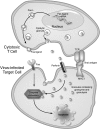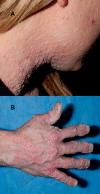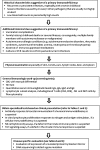Severe viral infections and primary immunodeficiencies
- PMID: 21960712
- PMCID: PMC3189169
- DOI: 10.1093/cid/cir610
Severe viral infections and primary immunodeficiencies
Abstract
Patients with severe viral infections are often not thoroughly evaluated for immunodeficiencies. In this review, we summarize primary immunodeficiencies that predispose individuals to severe viral infections. Some immunodeficiencies enhance susceptibility to disease with a specific virus or family of viruses, whereas others predispose to diseases with multiple viruses in addition to disease with other microbes. Although the role of cytotoxic T cells in controlling viral infections is well known, a number of immunodeficiencies that predispose to severe viral diseases have recently been ascribed to defects in the Toll-like receptor-interferon signaling pathway. These immunodeficiencies are rare, but it is important to identify them both for prognostic information and for genetic counseling. Undoubtedly, additional mutations in proteins in the innate and adaptive arms of the immune system will be identified in the future, which will reveal the importance of these proteins in controlling infections caused by viruses and other pathogens.
Figures




Similar articles
-
The syndrome of hemophagocytic lymphohistiocytosis in primary immunodeficiencies: implications for differential diagnosis and pathogenesis.Haematologica. 2015 Jul;100(7):978-88. doi: 10.3324/haematol.2014.121608. Epub 2015 May 28. Haematologica. 2015. PMID: 26022711 Free PMC article.
-
Viral infections complicating primary immunodeficiencies.Clin Ter. 1992 Feb;140(2):123-9. Clin Ter. 1992. PMID: 1568356 Review.
-
From idiopathic infectious diseases to novel primary immunodeficiencies.J Allergy Clin Immunol. 2005 Aug;116(2):426-30. doi: 10.1016/j.jaci.2005.03.053. J Allergy Clin Immunol. 2005. PMID: 16083801
-
Laboratory evaluation of primary immunodeficiencies.J Allergy Clin Immunol. 2010 Feb;125(2 Suppl 2):S297-305. doi: 10.1016/j.jaci.2009.08.043. Epub 2009 Dec 29. J Allergy Clin Immunol. 2010. PMID: 20042230 Free PMC article. Review.
-
Primary immunodeficiencies and susceptibility to parasitic infections.Parasite Immunol. 2006 Nov;28(11):567-75. doi: 10.1111/j.1365-3024.2006.00890.x. Parasite Immunol. 2006. PMID: 17042928 Review.
Cited by
-
Differential Diagnosis: Hepatic Complications in Inborn Errors of Immunity.J Clin Med. 2023 Dec 3;12(23):7480. doi: 10.3390/jcm12237480. J Clin Med. 2023. PMID: 38068532 Free PMC article. Review.
-
Toward Personalized Medicine: The Effect of Treatment of Chronic Enterovirus Diarrhea in an Immunocompromised Patient and the Correlation With In Vitro Models.Open Forum Infect Dis. 2025 Apr 10;12(5):ofaf212. doi: 10.1093/ofid/ofaf212. eCollection 2025 May. Open Forum Infect Dis. 2025. PMID: 40302715 Free PMC article.
-
Immune responses after live attenuated influenza vaccination.Hum Vaccin Immunother. 2018 Mar 4;14(3):571-578. doi: 10.1080/21645515.2017.1377376. Epub 2018 Jan 3. Hum Vaccin Immunother. 2018. PMID: 28933664 Free PMC article. Review.
-
The challenge of developing a herpes simplex virus 2 vaccine.Expert Rev Vaccines. 2012 Dec;11(12):1429-40. doi: 10.1586/erv.12.129. Expert Rev Vaccines. 2012. PMID: 23252387 Free PMC article. Review.
-
The surveillance of viral infections by the unconventional Type I NKT cell.Front Immunol. 2024 Sep 17;15:1472854. doi: 10.3389/fimmu.2024.1472854. eCollection 2024. Front Immunol. 2024. PMID: 39355244 Free PMC article. Review.
References
-
- Casanova JL, Abel L, Quintana-Murci L. Human TLRs and IL-1Rs in host defense: natural insights from evolutionary, epidemiological, and clinical genetics. Annu Rev Immunol. 2011;29:447–91. - PubMed
-
- Coffey AJ, Brooksbank RA, Brandau O, et al. Host response to EBV infection in X-linked lymphoproliferative disease results from mutations in an SH2-domain encoding gene. Nat Genet. 1998;20:129–35. - PubMed
-
- Sayos J, Wu C, Morra M, et al. The X-linked lymphoproliferative-disease gene product SAP regulates signals induced through the co-receptor SLAM. Nature. 1998;395:462–9. - PubMed
-
- Rigaud S, Fondaneche MC, Lambert N, et al. XIAP deficiency in humans causes an X-linked lymphoproliferative syndrome. Nature. 2006;444:110–4. - PubMed

